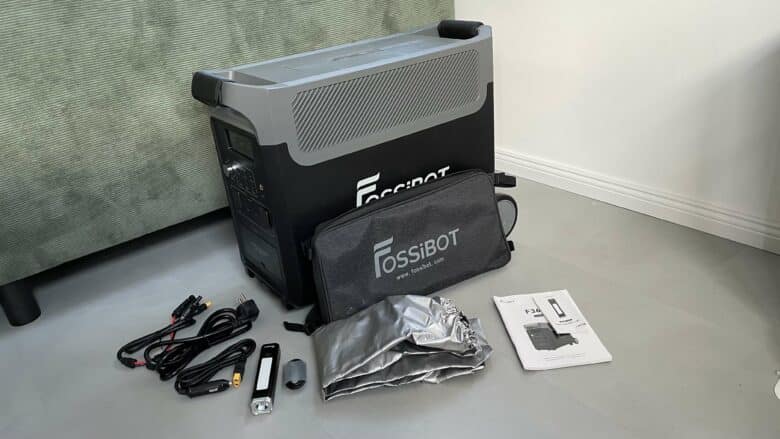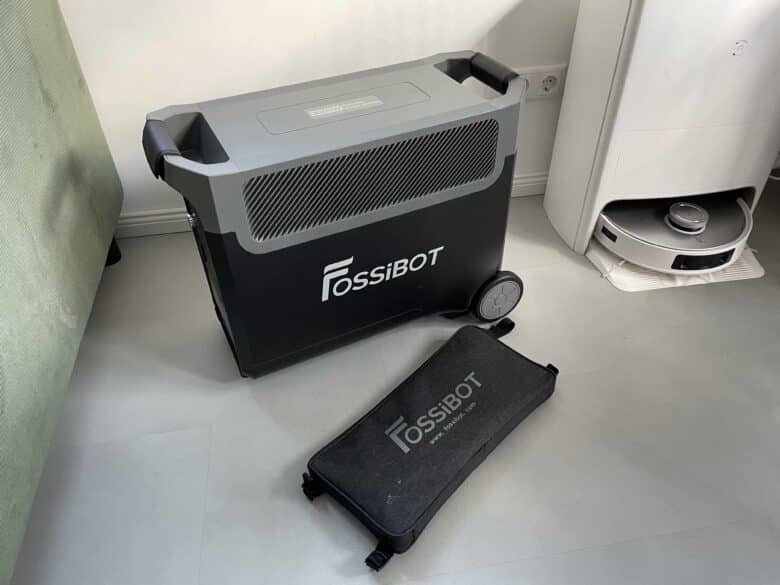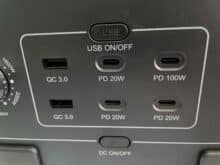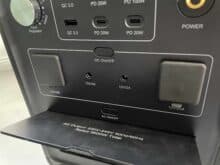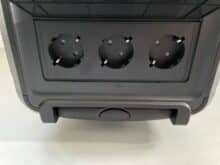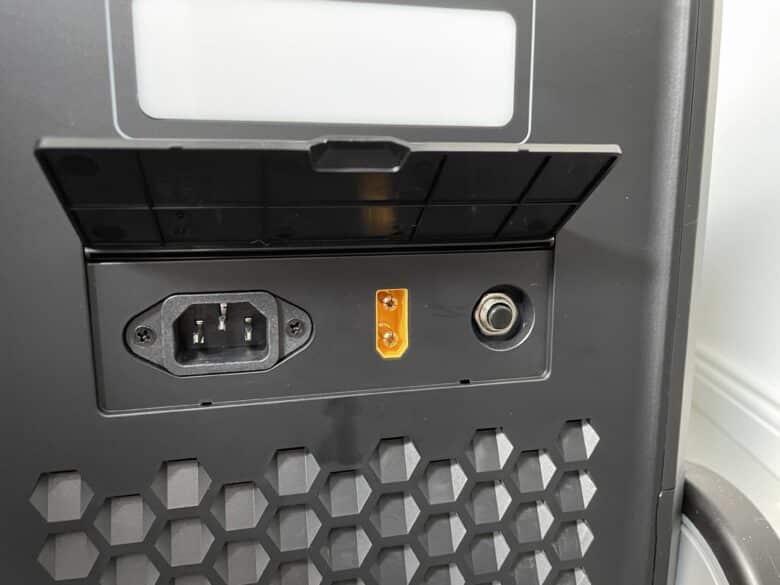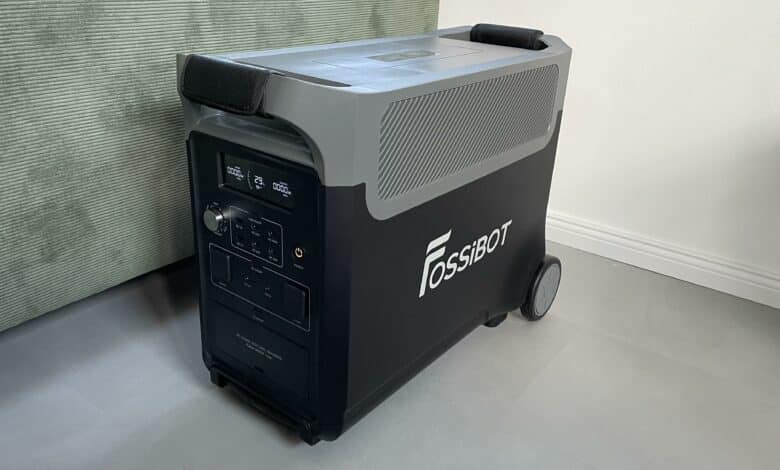
Mobile energy storage units are now available in all shapes, colors and sizes. There are not only power stations that you can easily put in your backpack for the hiking tour. In addition to medium-sized models, you can also find models on the market that can only be carried by two people. In today’s FOSSiBOT F3600 review, we want to take a closer look at a storage device that primarily wants to score with performance. With a sporty weight of 42 kg, the energy storage device equipped with wheels offers a battery capacity of 3840 Wh as well as a constant output power of 3600 W. It can thus not only be used on the go. This means it can not only be used on the road. The technical data also qualifies it as an enduring power supplier in your own four walls. Is this the ultimate price-performance hit? We’ll tell you.
Technical data
| Power | 3600 W (constant) 7200 W (transient peak power) |
| Battery capacity | 3840 Wh |
| Battery technology | LiFePO4 |
| Lifetime | approx. 6500 charge cycles |
| Outputs | 3x Schuko socket (AC with 230 V). 2x USB-A (18 W and QuickCharge 3.0) 3x USB-C (20 W with PD) 1x USB-C (100 W with PD) 2x DC5521 (12V/3A) 1x car connector (12V/10A) 1x XT60 (12V/25A) |
| Inputs | AC, solar and car connection |
| charging time | AC charging: approx. 2h at 2200 W. Solar charging: approx. 2.4 h at 2000 W Car charging: approx. 28 h Combined charging AC + solar: 1.5 h |
| Uninterruptible Power Supply (UPS) | Yes |
| App support | No |
| Price | € 1,799.99 * (Basic version without solar panel) |
Scope of delivery
Since the Powerstation alone weighs in at 42 kg, it’s no surprise that the packaging of the mobile energy storage device comes across as quite large and, above all, heavy. Inside, you’ll find not only the FOSSiBOT F3600, but also matching accessories. In addition to an AC charging cable for the home Schuko socket, the manufacturer also includes a car charging cable and an XT90 solar cable.
This provides the most common charging options as well as the appropriate cables. A matching case for easier transport is also provided. Furthermore, FOSSiBOT includes a practical gadget that is especially worthwhile on the construction site or in the outdoor area – a separate flashlight that adheres to metal thanks to a magnet. A handle cover made of imitation leather, a protective cover for the entire case, and the matching user manual round off the rather lush scope of delivery.
Design reminiscent of EcoFlow
- Optics with strong borrowings from EcoFlow
- Combination of light and dark gray
- 61 x 32 x 48 cm and 42 kg
For those who know a little about power stations, the look of the FOSSiBOT F3600 will seem familiar. Thus, the manufacturer opts for a completely different design language here than with the slightly smaller FOSSiBOT F2400 (test) and is rather oriented towards the models from EcoFlow. At times, it even reminds us of a large version of the EcoFlow Delta 2 (test). The 61 x 32 x 48 cm large and 42 kg heavy case has a light gray upper side including carrying handles on the right and left as well as large ventilation slots. The part underneath is again dark gray. In view of the sporty weight, the manufacturer provides two wheels here, which remind us of a rolling suitcase.
Matching leatherette handle covers are included and promise durability. The test showed that this transport relief is worth its weight in gold in practice. On the front of the F3600 you’ll find a multitude of outlets. Beyond that, the manufacturer places the display, which provides information about the most important status values. As it is now common in the market, you can not only read the battery capacity here. The screen also displays incoming and outgoing power. You can also see which inputs and outputs are currently in use and how long it will take to completely discharge or recharge. Furthermore, you can regulate the maximum input power.
Resilience and Durability
- Integrated and separate flashlight
- Rugged build quality promises good protection
- Display is informative
Since FOSSiBOT still does not have a suitable app ready, it is necessary in practice that the display is so meaningful. Personally, I have missed at least no app in my test phase. On the back are the three inputs for solar, AC and car cables as well as the two flashlights.
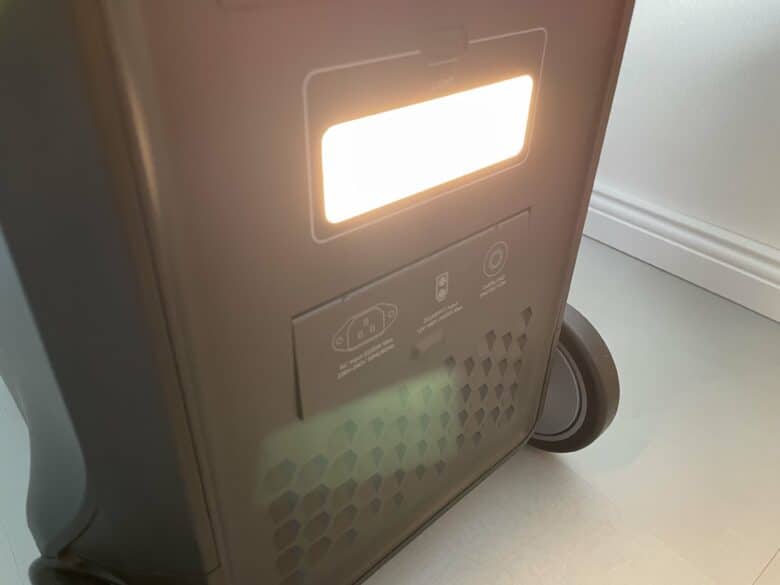
One sits in the device and you can easily attach and detach the other via a magnetic mechanism. It’s not just the looks that are strongly reminiscent of EcoFlow. FOSSiBOT’s model does not have to hide in terms of build quality either. The massive power station looks robust and durable. You definitely don’t have to worry about impact damage or the like here.
13 charging options on board
- 3x Schuko socket (AC with 230 V)
- 2x USB-A (18 W and QuickCharge 3.0)
- 3x USB-C (20 W with PD)
- 1x USB-C (100 W with PD)
- 2x DC5521 (12V/3A)
- 1x car connector (12V/10A)
- 1x XT60 (12V/25A)
The connection diversity of the FOSSiBOT F3600 can be quite impressive. Here you have the ability to charge up to 13 devices simultaneously. On the front are three Schuko sockets (AC with 230 V), 2x USB-A (18 W and QuickCharge 3.0), 3x USB-C (20 W with PD), 1x USB-C (100 W with PD), 2x DC5521 (12V/3A), 1x car connector (12V/10A) and 1x XT60 (12V/25A). Thus, everyone should be able to find what they are looking for. Nevertheless, the power station is not necessarily state-of-the-art in terms of connectivity. For one, I miss a Qi charging surface on the top.
Since there is plenty of space there, FOSSiBOT could have even accommodated two or more charging surfaces for wireless charging here, following the example of an AlphaESS BlackBee 2000 (test). Furthermore, I find the USB-C technology a bit undersized. In my opinion, one USB-C port with 100 W PD is not enough. The other three USB-C ports with 20 W each could have offered more power. If that does not bother you, you can at least enjoy a variety of ports here, which is something to be proud of.
Charging via socket, solar or car
Sooner or later, even a large power station like the FOSSiBOT F3600 will run out of energy. Then you’ll have to recharge it willy-nilly. Fortunately, this is a pleasantly quick process with this model. The F3600 only needs just under 2 hours via the household socket. This is made possible by a maximum input power of 2200 W via AC.
With the right solar modules, you can supply the power station with up to 2000 W of input power. Thus, it can be fully charged within 2.4 hours with solar energy alone. You’ll have to be patient if you charge it from your car. By the way, the fastest way is to combine the household socket with solar panels.

Here you can charge the powerstation with up to 4200 W, which makes a full charge possible within 1 hour 50 minutes. However, it should also be noted here that you should only exhaust the blazingly fast charging speeds if you are in a hurry. The slower the battery is charged, the longer its lifespan. To make the charging process more gentle, you can simply use the dial on the display. Here you can regulate the maximum input power.
Performance
Just one look at the technical data makes it clear that the FOSSiBOT F3600 is a big one. And by that I don’t mean the dimensions, nor the weight. Above all, the performance is on an extremely high level and plays in a league with industry tops like an EcoFlow Delta Pro. For example, the mobile energy storage unit offers a constant output of 3600 W and is even capable of a transient peak output of 7200 W. This not only makes it ideally suited for construction machinery on the building site. On top of that, this qualifies the power station to be used as a domestic emergency power solution.
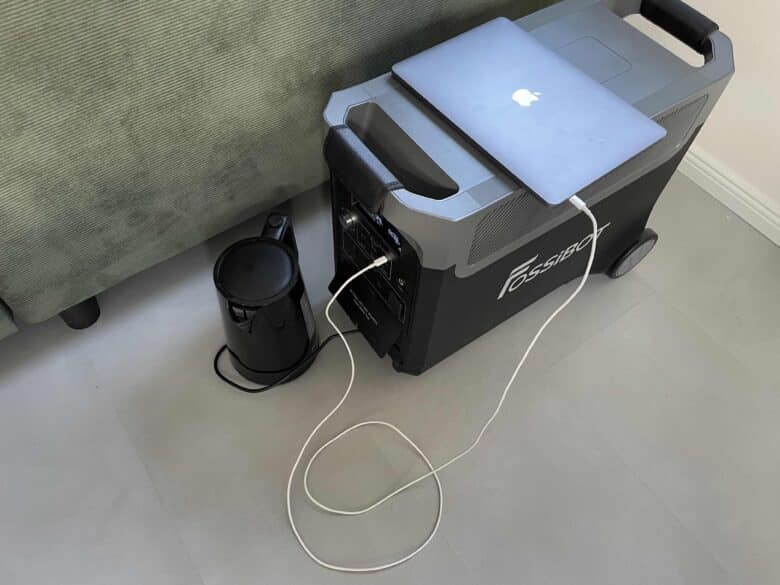
Thanks to the uninterruptible power supply (UPS) feature, it takes over the supply of the connected devices without further ado in the event of a power failure. Especially with devices such as the domestic refrigerator, this protection can be of great advantage. After all, you can protect yourself from spoiled food as a result of a power failure. Thanks to a switching time of 10 ms, you’ll hardly notice anything from the UPS. In the test, I let the power station supply my computer and removed the corresponding fuse from the socket to which the F3600 was connected. The computer continued to work reliably and didn’t let the power failure show.
Pass-through technology on board
What is especially advantageous in outdoor use is the pass-through technology. This allows the power station to be charged and discharged at the same time. For example, you can charge it at the campsite with your solar panel and use the electricity produced directly for kettles and the like. I connected everything from smartphones to microwaves and hammer drills to the power station. At no time did I notice that it was overtaxed. Consequently, it remains to be said that this is a real performance beast.
LiFePO4 for durability and safety
The battery of the FOSSiBOT F3600 is not only large and enduring. On top of that, the manufacturer relies on state-of-the-art battery technology here. Namely, no dusty lithium-ion batteries are used. Instead, FOSSiBOT uses LiFePO4 batteries, which are becoming increasingly popular and are known from electric cars. The advantages over lithium-ion batteries are manifold.

On the one hand, there is the longevity. The F3600 is supposed to last for 3,500 charging cycles until the maximum battery capacity drops to 80 percent. This means you can easily look forward to ten years of use. For average users, it should take even longer until this point is reached.
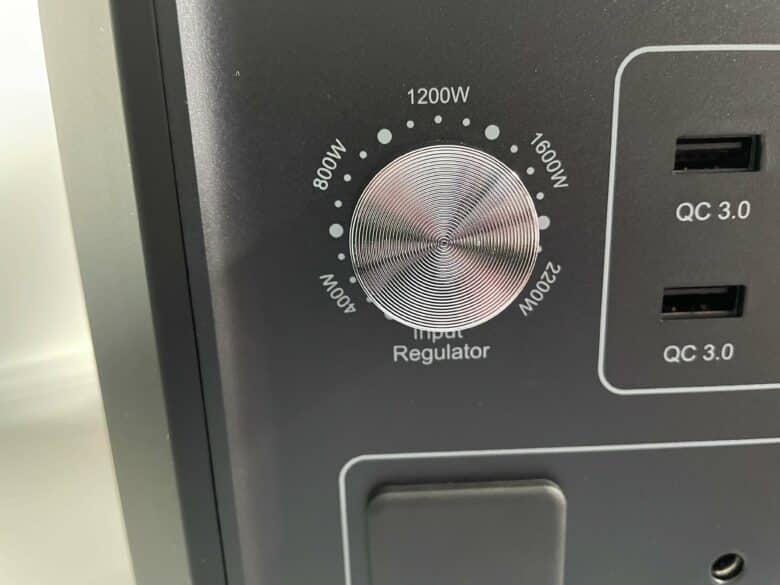
Finally, we assume daily use of the power station in the calculation. In addition to the long lifespan, it is primarily the safety that sets LiFePO4 batteries apart from their lithium-ion counterparts. The protection against extreme temperatures is significantly higher. On top of that, there is a much lower risk of fire or even explosion here.
Batteries not expandable
If you decide to buy a FOSSiBOT F3600, you will save several hundred euros compared to a Delta Pro from EcoFlow. Of course, this raises the question of what disadvantages you have to accept in return. We have already named one. The F3600 does not have a separate app that enables operation via smartphone. However, the manufacturer says that a corresponding solution will be added later. Another drawback, which might be much more serious for many, is the lack of expandability.
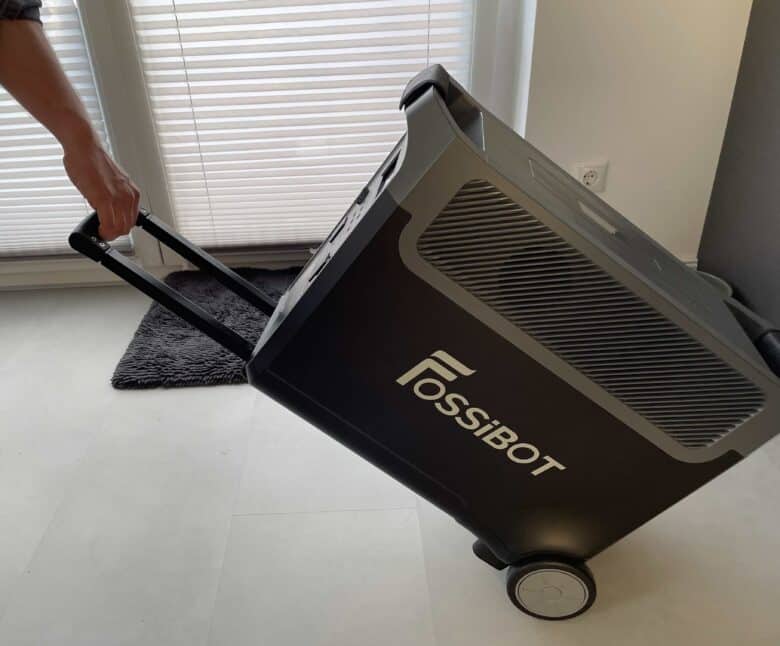
Thus, the Delta Pro can be expanded up to 25,000 Wh with the help of separately available additional batteries. Unfortunately, this is not possible with FOSSiBOT. Since in times of balcony power plants and roofs equipped with PV systems, more and more are aiming at such storage solutions, I can’t really understand this. Possibly, the manufacturer will go a different way with the next version. Given that the Powerstation guarantees so many years of life, expandability would have simply provided much more flexibility.
Conclusion
With the FOSSiBOT F3600, I was meanwhile allowed to take a closer look at the second power station from the manufacturer of modern energy solutions, which is still somewhat unknown in this country. As with the somewhat smaller F2400, the test result is once again very positive. I find the design of the larger power station much nicer than that of the F2400. However, the manufacturer has to accept the accusation that it has licked its chops a bit at the EcoFlow competition. The performance is beyond any doubt. You get 3600 W of constant and even 7200 W of transient power here. For its batteries, FOSSiBOT relies on modern, durable and safe LiFePO4 battery technology. A capacity of 3840 Wh speaks for impressive endurance. Unfortunately, this is also a big point of criticism.
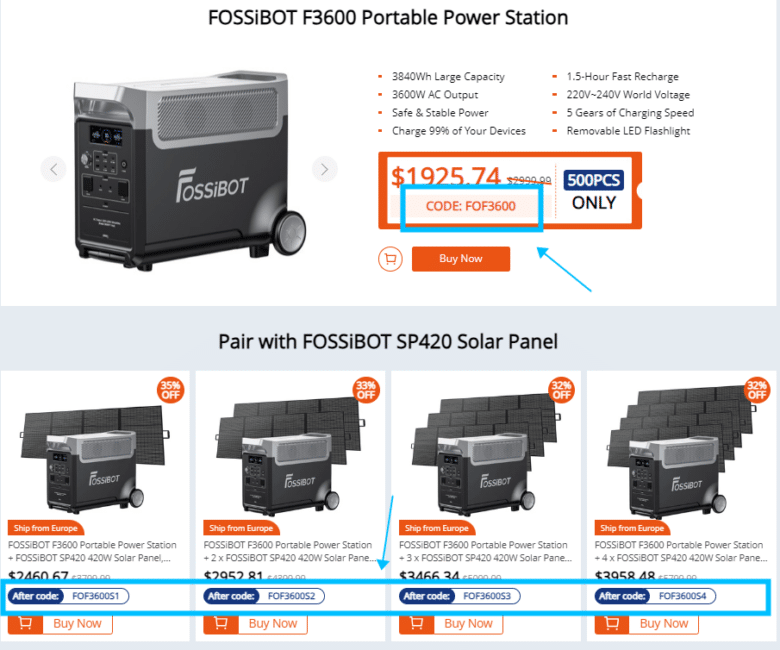
That’s how big the nearly 4000 Wh may be. However, the maximum battery capacity can unfortunately not be expanded. That could scare off one or the other. You will also look in vain for an app control. Furthermore, the USB-C ports seem a bit undersized in terms of output power. However, the price is not a deterrent at all. The FOSSiBOT F3600 is a real price-performance hit that can give established market participants like the EcoFlow Delta Pro a run for their money. At Geekbuying, you can secure the power station at a very low price. Until June 30, you can secure the Powerstation for 1,799.99 euros on the promotion page. If you pay via Paypal, you’ll save even more. Bundles with matching solar panels can also be secured directly. The timing could hardly be better in view of the sunny weather.
FOSSiBOT F3600
Workmanship & design
Hardware
Performance
Value for money
92/100
If you can put up with the small quirks, you will get a powerful power station for a small price with the FOSSiBOT F3600.

